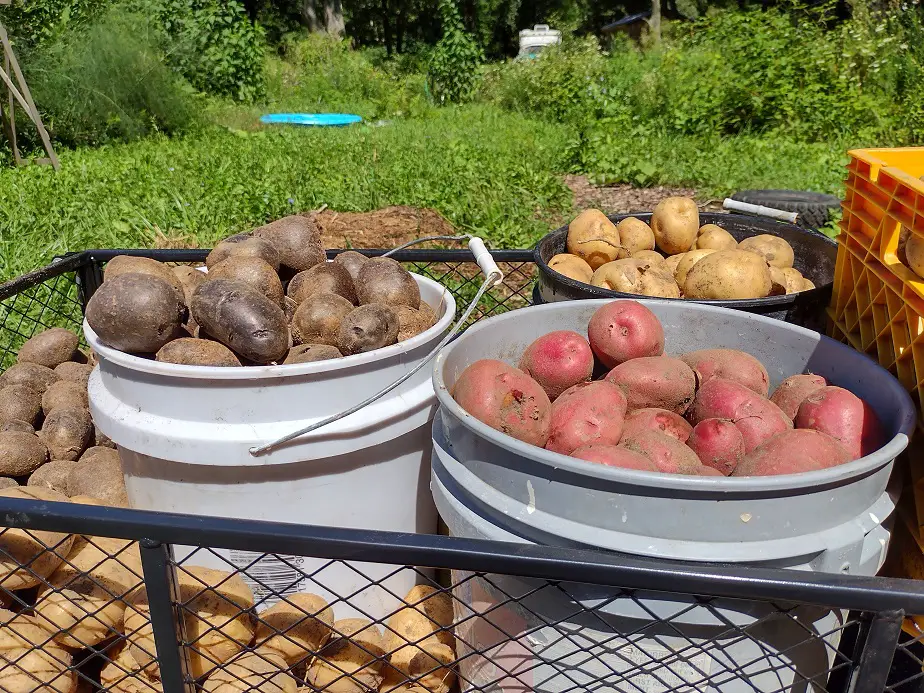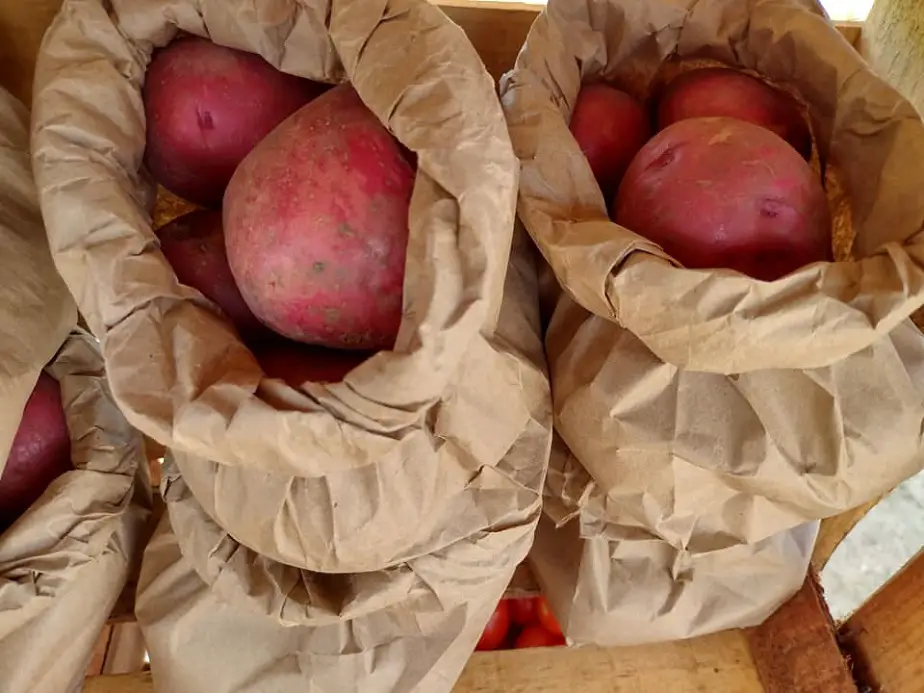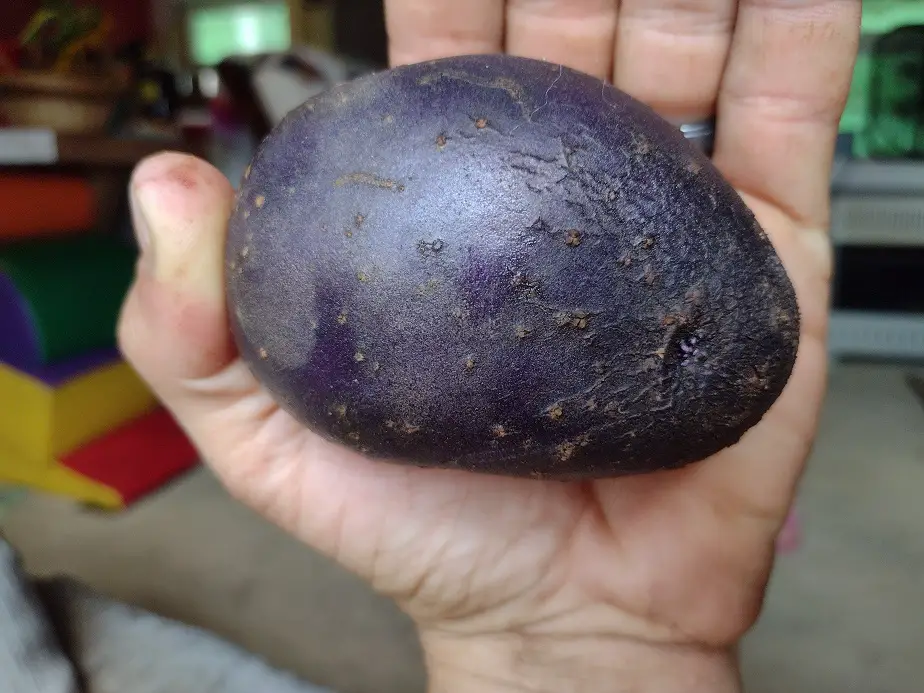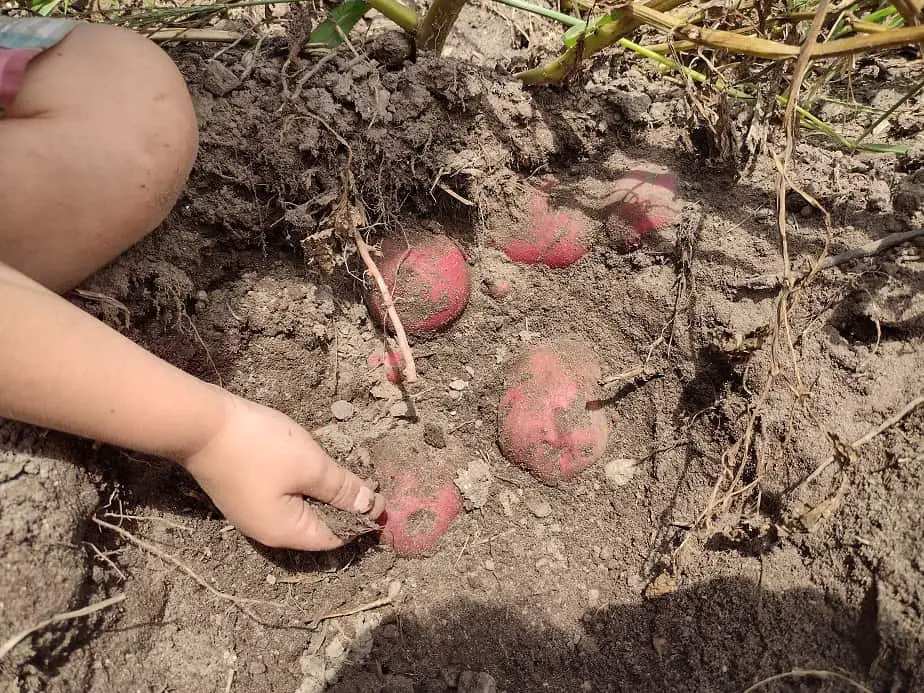So you have a good supply of potatoes, but how should you store them long-term? I’ll tell you what I do, and a few other options.
Basements, cellars, and crawlspaces are great places to store potatoes long-term. They can also be stored in a refrigerator. Store potatoes in a cool, dark place with some airflow. Potatoes store best within a consistent temperature and humidity level. They prefer a moderately humid but cool and dry environment.
I don’t have a basement or cellar. Still, we store hundreds of pounds of potatoes through winter for food and for planting. Here’s how we do it.

Storing Potatoes in 5-gallon Buckets
A 5-gallon bucket will hold about 20 pounds of potatoes. Dry, unwashed potatoes store well in a 5-gallon bucket. In good conditions, you can keep potatoes in buckets like this for up to six months without spoilage or rot. But, you have to keep up with it.
I stored two-hundred pounds of potatoes in buckers last fall/winter. It worked better than I expected it to to be honest. The main thing here is that you have to keep them fairly cool. I like to put the buckets in the coldest part of my house. Cool temperatures keep them from drying out too quickly.
I do put lids on the buckets, but I removed the rubber seal first, and I didn’t fully seat the lid so extra air could be exchanged. The only inherent problem with this is that it’s hard to spot one potato going bad. When one goes, The spuds touching it go bad very quickly. It spreads fast.
To deal with that, you should go through the buckets at least every two weeks. Just pour them out, toss out any bad ones, and put the good potatoes back in the bucket. Also, give the buckets the good ol’ smell test. A potato that’s going pad will smell like no man’s business. If you smell something off, deal with it then you’re good to go.
Eventually, they will probably get a bit dried out and wrinkled, but as long as they are not obviously spoiled, they’ll be good for cooking or planting. Some of our potatoes were so wrinkled, they didn’t look like they would have sprouted after planting in the spring. Most of them did.

Storing Potatoes In The Pantry
If you store potatoes in your pantry, be sure they are out of all sunlight. If your pantry is warmer, potatoes may not store well for more than a month. They just get dried and wrinkly pretty quickly in warm weather. But, if you want to keep potatoes in the cupboard, I recommend putting them in a bucket, basket, or paper sack.
A pile of potatoes will sort of create their own microclimate of humidity, keeping them nicer for longer. If you are going to put them in the pantry or cupboard, I’d certainly wash them first. The reason I normally try and avoid washing them is two-fold.
Firstly, the dirt helps to keep the moisture inside. Secondly, washing them tends to involve some level of scrubbing or other skin disturbance. Washing potatoes tends to lessen the integrity of the skin, making them tend to go bad faster. Also, when you do wash potatoes, let them dry completely before packing them away. Wet potatoes can go bad very quickly.

Storing Potatoes in a Refrigerator
Potatoes can be stored for up to nine months in a refrigerator. Commercial refrigeration barns are used to store potatoes before they are sold to stores. Potatoes do best with 90 to 95 percent humidity. High humidity keeps the integrity of the potato skin, preventing damage and disease in storage.
Potatoes do decent at a higher refrigerator temperature of 38 to 40 degrees. Most storage facilities are between 40 and 45 degrees perminately. Lower than 37 degrees gets too close to freezing should a small thing go wrong. Potatoes that have frozen are poor for eating and go bad very quickly once thawed.
If you are using a fridge, you should probably not store them too much along the sides of the refrigerator. When things do freeze out there, it’s usually right along some part of the wall.

Storing Potatoes in The Ground
The easiest way to store potatoes, providing you grew them yourself, is to just leave them in the soil until you want to get a basket full for your kitchen. I probably have 600 pounds of potatoes still in the soil, and it’s almost Christmas. Potatoes were being harvested in September. That was three months ago.
My potatoes are still doing great. There have been a few that have rotted, but not very much. And that was really only in rainy fall weather. I may go dig up a pile of spuds later today. I do like to eat potatoes. There’s a reason I grew about 3,000 pounds this year. They were not all for the market.
If you your potatoes freeze in the soil, they will go bad at the next thaw period. Where I am in west Michigan, if there is four or more inches of snow on the ground, I don’t expect the soil to be frozen. Still, a pile of leaves, straw, or even cornstalks would help insulate the soil to keep my potatoes from freezing should we get an overly frigid or snow-free winter. It does happen from time to time.
Now, if you don’t have really good drainage in your soil, don’t do this. Winter is a time when the soil tends to stay wet for a very long time. You can improve the drainage of your soil by practicing a no-till garden, and by amending it with biochar.
I’ve actually come across places where people will make a cache of potatoes in the ground. In a well-drained place like the side of a hill, a trench is dug and lined with gravel or stones to help drain away water. Then some straw or sandy soil is laid to protect the potatoes, and the trench is filled with potatoes. After a layer of straw on to as extra insulation, a foot of soil is put on top of the cache.
This can work incredibly well in a semi-cold environment like up here in Michigan. The only real issues with it are overly wet soil and voles. Those little burrowing voles, should they find your potato cache, would have a royal heyday, and a winter-long feast would ensue. If you really wanted, some hardware cloth (stout wire netting) could be used as a liner to keep them away.
Sources:

